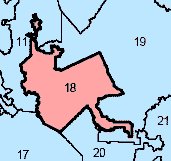I oppose Governor Schwarzenegger's redistricting proposal (Proposition 77 on tomorrow's ballot) because it's the wrong approach to a real problem. The current system of redistricting is broken and needs to be fixed. However, the solution is to take the time to build a better redistricting plan in time for the 2010 census.
The current system of redistricting is broken and needs to be fixed. However, the solution is to take the time to build a better redistricting plan in time for the 2010 census.
A real redistricting plan should have objective criteria to ensure that districts are geographically compact — without the ridiculous "fingers" of California's 18th Congressional district protruding into the 11th and 19th districts, just for one obvious example. I didn't have to look very hard to find a district with a couple of crazy creepie crawlies poking into one or more neighboring districts, either.
The other objective criterion should be the preservation of communities of interest. Could anyone say that Lathrop (in the northernmost part of the 18th district) should be separated from Tracy and Manteca (on either side in the 11th district)? Does the shape of this district make any sense to anyone other than a computer designed to protect incumbents from any meaningful competition?
In general, counties provide a fairly good demarcation of communities of interest, but not always. For example, when the 510 area code in the eastern San Francisco Bay Area was split to form the 925 area code, one possibility was to split along the county line, with Alameda County keeping 510 while Contra Costa County changed to 925. However, the concerns and issues in the East Bay align more closely with the natural landmark formed by the Oakland Hills than with the artificial county boundary. Thus, the bayside portion (most of Alameda, plus western Contra Costa) kept 510, while the inland portion (most of C.C., plus the area around Livermore) changed to 925.
In similar fashion, Congressional districts should generally follow county lines, except where a deviation would serve to better preserve the integrity of communities of interest.
The governor's plan places the power to draw districts in the hands of three retired judges — either two Republicans and one Democrat, or vice-versa. Moreover, the population of retired judges in California is a poor reflection of the diversity of the population as a whole. A triumvirate of grumpy old men smacks of smoke-filled back rooms. Instead, we need a larger commission, including representation of various political parties, racial/ethnic groups, urban/suburban/rural interests, and other elements of the diversity that is California.
I challenge the legislature to craft a plan to create a redistricting commission that can operate in the public interest, with transparency and due consideration for the many issues raised by the creation of fifty-odd Congressional districts, eighty Assembly districts, and forty state Senate districts. You've got about four years to work out the details, so you might want to get started soon.
Monday, November 07, 2005
Real redistricting
Posted by
Lincoln Madison
at
4:55 PM
![]()
Subscribe to:
Comment Feed (RSS)
|